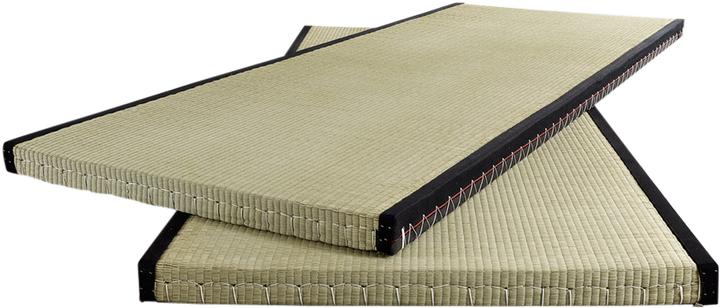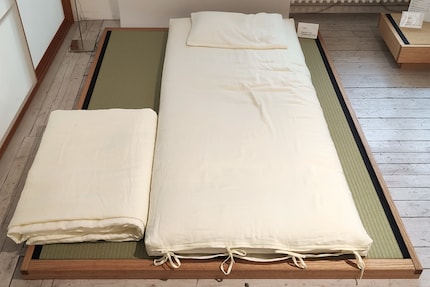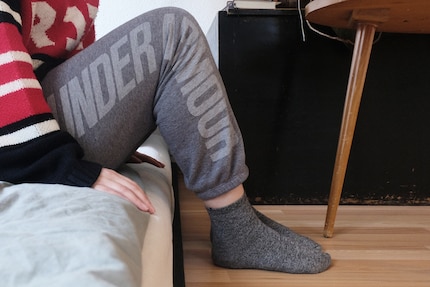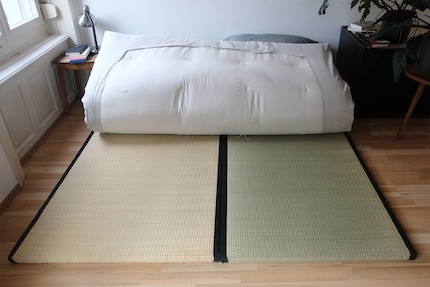

Bye-bye bed, Konnichiwa tatami!
I’ve been sleeping on the floor for a few weeks now. Two handbreadths above it, to be precise. After a few nights of transition, I can now say: I prefer my tatami mat to my old bed.
Rewind: the tatami mat made its way into my apartment as a rudimentary guest bed. Acute back pain brought on by a working-from-home setup had my boyfriend seeking relief on the floor. The firmness helped and his pain lessened. He became reluctant about lying down on the thick mattress in our 160 centimetre wide wooden bed. A period of sleeping at different heights ensued. His solution to level things out again? Bed out, tatami in.
Two mats, one futon
After a bit of huffing and puffing, I went along with the idea. Partly swayed by the fact that many of you out there seem to be very comfortable with your tatami sleeping setup. For example, this is what Aurifere had to say about the first post: «I’ve suffered from back problems since I was small. Provided it doesn’t cause you pain, you should get the tatami bed for two.»
So off I went and ordered a second Japanese tatami made in China. An inexpensive rice straw mat would be good enough, as I wanted to focus on the futon quality, instead. The one my boyfriend had been sleeping on was way too thin for my taste. Whenever I rolled over on it, I felt pressure on my shoulder and hip. This discomfort made me wake up several times a night. So the new futon would have to be thicker and 180 centimetres wide. I didn’t want to get single ones, as I’d only end up sleeping in the gap between them.

At a specialist shop for Japanese living, I tested out a bunch of exhibited futons: from camel hair to vegan to extra thin to thick as a standard mattress. After some lying about, I went for a futon made from a blend of virgin wool, cotton and horsehair. My hips and shoulders felt comfortably cushioned without sacrificing that sense of firm support. At least during the 62 seconds I spent on it in the shop.

Four weeks later, the futon was ready to be picked up and hauled home on foot. At that time, I had already been sleeping on the floor for two weeks. Our bed was banished to the basement. To make the transition easier for me, I put a 22-centimetre-thick mattress on top of the 5.5-centimetre-thick tatami mat. Granted, this somewhat distorted the real Japanese sleeping experience. Upon first testing, the 12-centimetre futon felt just as good as it did when I first laid down on it in the shop.
The first nights were rough
Then came the first night. I woke up five times. Usually, I fall asleep before my head hits the pillow and don’t open my eyes until the horrible sound of my mobile phone alarm clock goes off. I couldn’t handle the hardness. My hips and shoulders were sore. Oh dear. Should I have gone for the «comfort» model with its extra precious centimetres of thickness? I quickly brushed aside this thought. After all, the futon was perfect for me. It was me that wasn’t perfect for the futon yet. I’m stubborn like that and defend decisions I’ve made to the death. Even if this means lying to myself.
This went on for a few nights. Until suddenly... everything was fine. There’s no need to sugarcoat my purchase anymore. My body and the futon have got used to each other. I now sleep through the night again and feel less crumpled in the mornings than I did with our old Ikea mattress.

But getting out of bed is a new challenge. My legs no longer touch the floor at a right angle when I’m sitting on the edge of the bed. Instead, they’re angled at 45 degrees max. This makes getting up a little less elegant. I often roll out of bed onto all fours before assuming a standing position. My guess is, sleeping on a tatami mat is probably not recommended for individuals aged 70 or older. At least not for averagely athletic people who haven’t spent all their lives sleeping on this type of bed.
But until then, I’m sticking to the tatami. I’m liking both the way my body feels first thing as well as the aesthetics of the bed. It looks much less space-consuming than a bulky bed. The natural materials and colours also have a calming effect on the eye and mind. As you can’t wash a futon, I’ve covered it with a mattress protector and a special bed sheet made of linen and organic cotton. Once a fortnight, the bed system should be propped up against a wall so the mats don’t absorb too much moisture.

What I still need now is a matching bedside table. An old box storing bed linen and towels is currently serving as my book and mobile table. It’s definitely not the right height. But that’s not important. At least my boyfriend and I are on the same level again. When we’re asleep anyway.
My life in a nutshell? On a quest to broaden my horizon. I love discovering and learning new skills and I see a chance to experience something new in everything – be it travelling, reading, cooking, movies or DIY.


